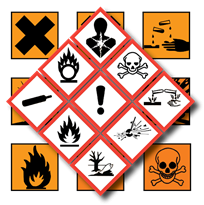Classification and labelling identify hazardous chemicals and inform users throughout the EU about their hazards through standard symbols and phrases. They ensure good worldwide understanding and facilitate the free flow of goods. In the EU, Regulation 1272/2008 on classification, labelling and packaging of substances and mixture (the CLP Regulation) governs the classification, labelling and packaging of chemicals.
Read more on the CLP Regulation, its adaptations to technical progress, and related legislation.
Read more on the EU’s chemicals strategy for sustainability.
Spotlight
Brexit
How Brexit affects you.
The UK withdrew from the EU on 31 January 2020.
Whether you are a chemicals company based in the EU/EEA or the UK, you need to adapt to the changes.
See the Brexit support page of the European Chemicals Agency (ECHA).
See the Commission’s Brexit page.
Poison centres
How to notify about hazardous chemicals.
All EU countries have ‘poison centres’. They receive information on dangerous mixtures so that they can formulate emergency measures where necessary.
As of 1 January 2021, businesses throughout the EU must inform poison centres in the same format.
See ECHA’s poison centres page for your obligations to notify about hazardous chemicals.
See our poison centres page.
Background
What is the Globally Harmonised System?
The United Nations' Globally Harmonised System of Classification and Labelling of Chemicals (GHS) provides globally uniform physical, environmental, and health and safety information on hazardous chemical substances and mixtures. It sets up criteria for the classification of chemicals for physical-chemical, health, and environmental hazards of chemical substances and mixtures. It also sets up standardised hazard information to facilitate the global trade of chemicals. The GHS was adopted by the United Nations in 2002 and is periodically updated. As a front-runner, the EU implemented the GHS in the EU in 2008.
What is CLP?
The Regulation on classification, labelling and packaging (CLP Regulation) implements the GHS since 20 January 2009. The deadlines for substance and mixture classification under the new rules were 1 December 2010 and 1 June 2015, respectively. The CLP Regulation replaces previous legislation on classification, labelling and packaging of substances (Directive 67/548/EEC) and preparations (Directive 1999/45/EC).
In line with the GHS standard, CLP helps producers identify hazardous chemicals and inform users about them through labelling. CLP is also the basis for safety data sheets (SDS), managed through the REACH Regulation, and sets requirements for hazardous chemicals’ packaging.
Hazard identification and classification
The hazard identification process allows the assessment of information about the intrinsic properties of a substance or mixture to determine its potential to cause harm. There are hazard classes for physical hazards, health hazards, and environmental hazards. If the nature and severity of an identified hazard meet the classification criteria in Annex I to the CLP Regulation, a certain hazard class will be assigned to the substance or mixture.
For most substances and mixtures, manufacturers, importers, downstream users and distributors must determine the hazard classification themselves. In certain cases, the classification of a chemical is harmonised at EU level. The list of harmonised classification and labelling is included in Annex VI to the CLP Regulation.
For more information on the classification process, including guidance documents, please consult ECHA’s page on classification.
Labelling

Once the substance or mixture is classified based on its hazards, the hazards need to be communicated to the user. The label of a hazardous substance or mixture includes pictograms, signal words, hazard statements, precautionary statements, and supplemental statements. Under the CLP Regulation, from 1 June 2015, new pictograms in the shape of a red diamond with a white background replaced the orange ones in the EU. See more information on ECHA’s page on CLP 2017.
For more information on the labelling of hazardous substances and mixtures, including guidance documents, please consult ECHA’s page on labelling.
Packaging
CLP sets general packaging rules to ensure the safe supply of hazardous substances and mixtures in the EU market. For certain hazards, substances and mixtures need to carry child-resistant fastenings and/or tactile warnings.
There are different rules on classification and labelling for international transport purposes. These rules follow the United Nations Recommendations on the Transport of Dangerous Goods with close links to the UN GHS. For more information on classification and labelling for transport, see the Directorate-General for Mobility and Transport website.
Key players
The European Commission, the European Chemicals Agency, and international organisations all play a role in CLP and GHS.
- Read more on the role of CLP key players
Guidance and Helpdesks
Guidance on how to apply the provisions of the CLP Regulation is available from the CLP guidance section of ECHA's website, including the Introductory Guidance on the CLP Regulation and the Guidance on the Application of the CLP Criteria.
National helpdesks have been established to provide guidance in national languages. Their contact details are available from the helpdesk section of ECHA's website.
Links
Archive
The following pages contain archived information on the preparation of the CLP Regulation.
- Impact assessment and introduction of the draft CLP Regulation in 2008 (689KB)
- Summary of the public consultation on the draft CLP Regulation in 2006 (236KB)
The following pages contain archived information on the implementation of Directive 1999/45/EC (Dangerous Preparations Directive), which was repealed on 1 June 2015.
- Unofficial consolidated version of the Directive 1999/45/EC
- Position paper (48KB) on the classification and labelling of preparations with extreme pH values as corrosive under Directive 1999/45/EC
